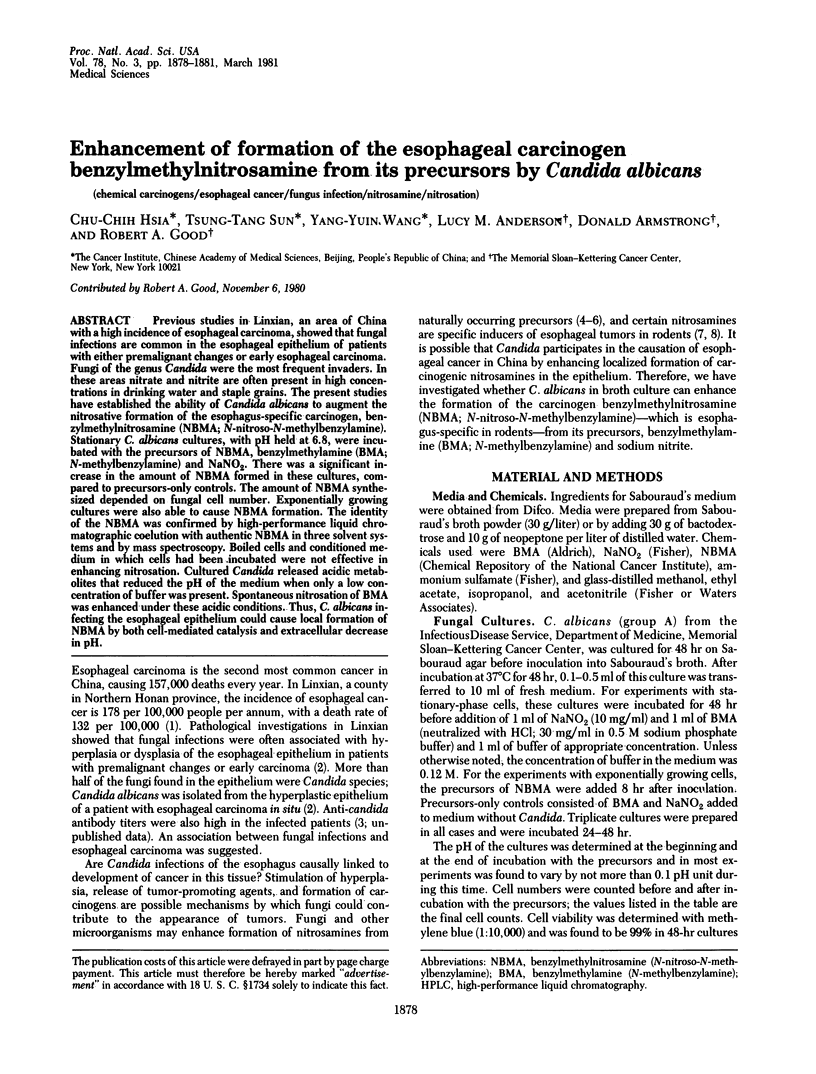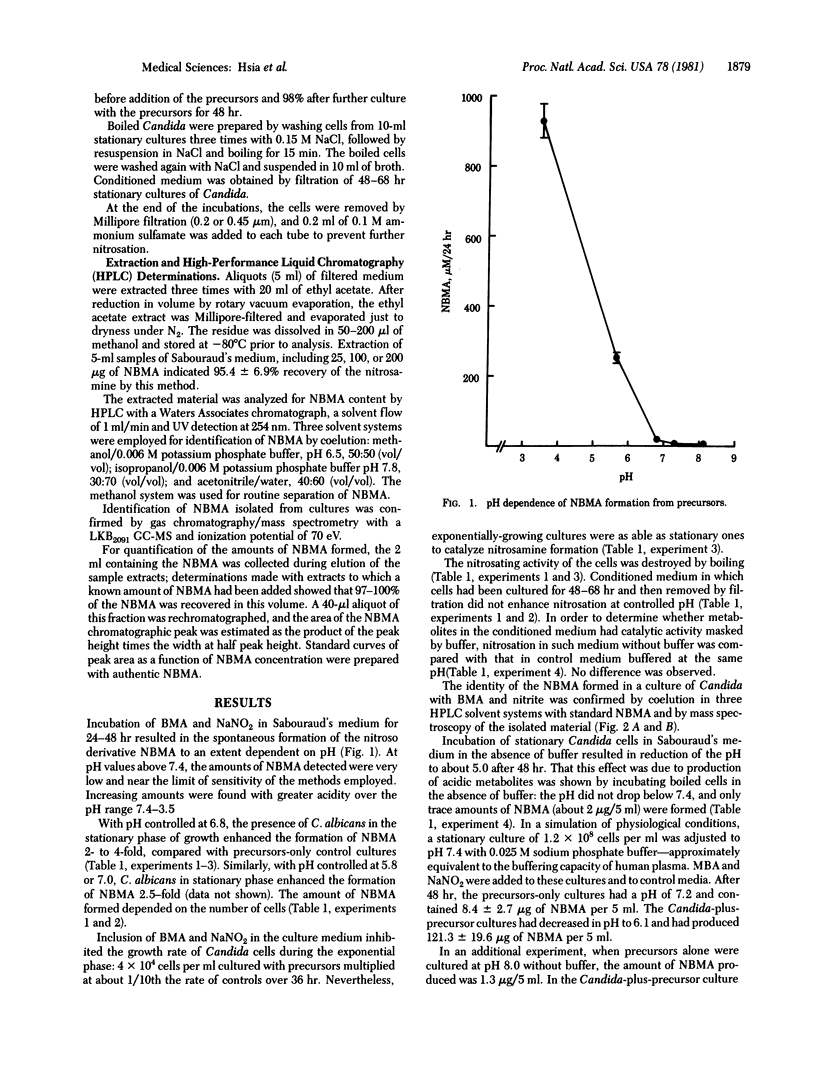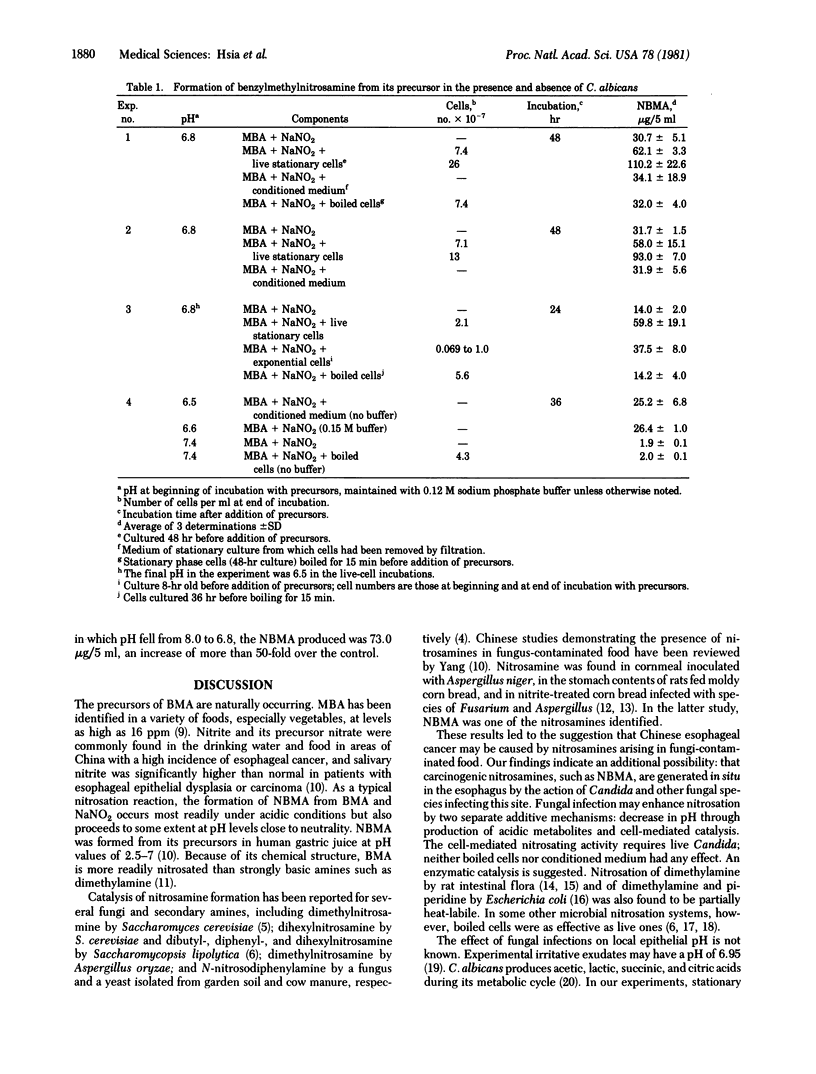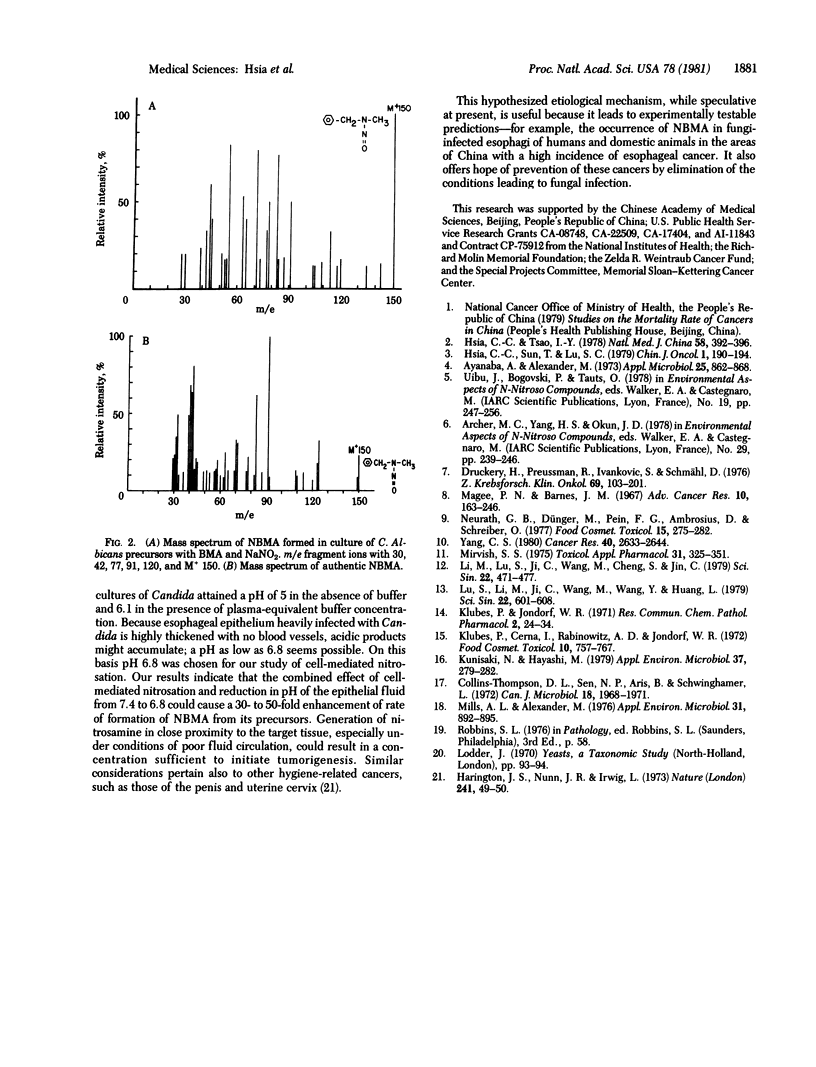Abstract
Previous studies in Linxian, an area of China with a high incidence of esophageal carcinoma, showed that fungal infections are common in the esophageal epithelium of patients with either premalignant changes or early esophageal carcinoma. Fungi of the genus Candida were the most frequent invaders. In these areas nitrate and nitrite are often present in high concentrations in drinking water and staple grains. The present studies have established the ability of Candida albicans to augment the nitrosative formation of the esophagus-specific carcinogen, benzylmethylnitrosamine (NBMA; N-nitroso-N-methylbenzylamine). Stationary C. albicans cultures, with pH held at 6.8, were incubated with the precursors of NBMA, benzylmethylamine (BMA; N-methylbenzylamine) and NaNO2. There was a significant increase in the amount of NBMA formed in these cultures, compared to precursors-only controls. The amount of NBMA synthesized depended on fungal cell number. Exponentially growing cultures were also able to cause NBMA formation. The identity of the NBMA was confirmed by high-performance liquid chromatographic coelution with authentic NBMA in three solvent systems and by mass spectroscopy. Boiled cells and conditioned medium in which cells had been incubated were not effective in enhancing nitrosation. Cultured Candida released acidic metabolites that reduced the pH of the medium when only a low concentration of buffer was present. Spontaneous nitrosation of BMA was enhanced under these acidic conditions. Thus, C. albicans infecting the esophageal epithelium could cause local formation of NBMA by both cell-mediated catalysis and extracellular decrease in pH.
Keywords: chemical carcinogens, esophageal cancer, fungus infection, nitrosamine, nitrosation
Full text
PDF



Selected References
These references are in PubMed. This may not be the complete list of references from this article.
- Ayanaba A., Alexander M. Microbial formation of nitrosamines in vitro. Appl Microbiol. 1973 Jun;25(6):862–868. doi: 10.1128/am.25.6.862-868.1973. [DOI] [PMC free article] [PubMed] [Google Scholar]
- Collins-Thompson D. L., Sen N. P., Aris B., Schwinghamer L. Non-enzymic in vitro formation of nitrosamines by bacteria isolated from meat products. Can J Microbiol. 1972 Dec;18(12):1968–1971. doi: 10.1139/m72-306. [DOI] [PubMed] [Google Scholar]
- Druckrey H., Preussmann R., Ivankovic S., Schmähl D. Organotrope carcinogene Wirkungen bei 65 verschiedenen N-Nitroso-Verbindungen an BD-Ratten. Z Krebsforsch. 1967;69(2):103–201. [PubMed] [Google Scholar]
- Harington J. S., Nunn J. R., Irwig L. Dimethylnitrosamine in the human vaginal vault. Nature. 1973 Jan 5;241(5384):49–50. doi: 10.1038/241049b0. [DOI] [PubMed] [Google Scholar]
- Klubes P., Cerna I., Rabinowitz A. D., Jondorf W. R. Factors affecting dimethylnitrosamine formation from simple precursors by rat intestinal bacteria. Food Cosmet Toxicol. 1972 Dec;10(6):757–767. doi: 10.1016/s0015-6264(72)80002-6. [DOI] [PubMed] [Google Scholar]
- Klubes P., Jondorf W. R. Dimethylnitrosamine formation from sodium nitrite and dimethylamine by bacterial flora of rat intestine. Res Commun Chem Pathol Pharmacol. 1971 Jan;2(1):24–34. [PubMed] [Google Scholar]
- Kunisaki N., Hayashi M. Formation of N-nitrosamines from seconday animes and nitrite by resting cells of Escherichia coli B. Appl Environ Microbiol. 1979 Feb;37(2):279–282. doi: 10.1128/aem.37.2.279-282.1979. [DOI] [PMC free article] [PubMed] [Google Scholar]
- Li M., Lu S., Ji C., Wang M., Cheng S., Jin C. Formation of carcinogenic N-nitroso compounds in corn-bread inoculated with fungi. Sci Sin. 1979 Apr;22(4):471–477. [PubMed] [Google Scholar]
- Magee P. N., Barnes J. M. Carcinogenic nitroso compounds. Adv Cancer Res. 1967;10:163–246. doi: 10.1016/s0065-230x(08)60079-2. [DOI] [PubMed] [Google Scholar]
- Mills A. L., Alexander M. N-Nitrosamine formation by cultures of several microorganisms. Appl Environ Microbiol. 1976 Jun;31(6):892–895. doi: 10.1128/aem.31.6.892-895.1976. [DOI] [PMC free article] [PubMed] [Google Scholar]
- Mirvish S. S. Formation of N-nitroso compounds: chemistry, kinetics, and in vivo occurrence. Toxicol Appl Pharmacol. 1975 Mar;31(3):325–351. doi: 10.1016/0041-008x(75)90255-0. [DOI] [PubMed] [Google Scholar]
- Neurath G. B., Dünger M., Pein F. G., Ambrosius D., Schreiber O. Primary and secondary amines in the human environment. Food Cosmet Toxicol. 1977 Aug;15(4):275–282. doi: 10.1016/s0015-6264(77)80197-1. [DOI] [PubMed] [Google Scholar]
- Shixin L., Mingxin L., Chuan J., Mingyao W., Yinglin W., Liang H. A new N-nitroso compound, N-3-methylbutyl-N-1-methylacetonylnitrosamine, in corn-bread inoculated with fungi. Sci Sin. 1979 May;22(5):601–607. [PubMed] [Google Scholar]
- Yang C. S. Research on esophageal cancer in China: a review. Cancer Res. 1980 Aug;40(8 Pt 1):2633–2644. [PubMed] [Google Scholar]


